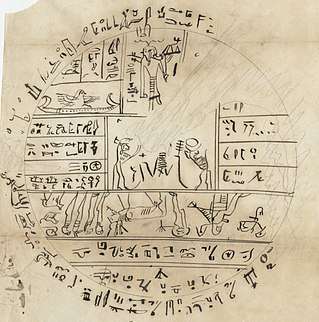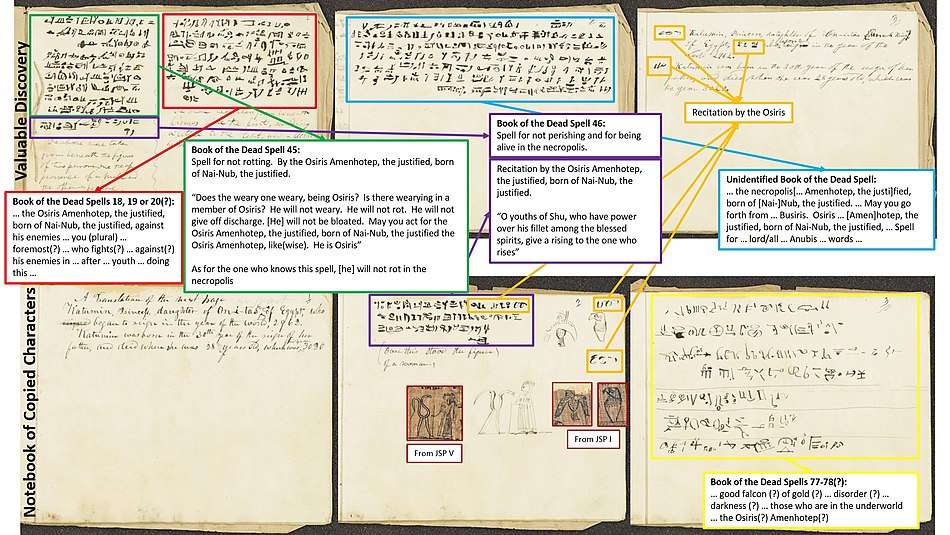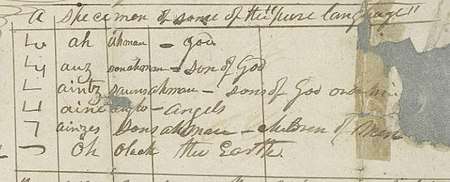Kirtland Egyptian papers
The Kirtland Egyptian papers (KEP) are a collection of documents related to the Book of Abraham during the Kirtland period of early Mormonism (early to mid-1830s). The papers include an "Egyptian Alphabet and Grammar" written in the hand of Joseph Smith, Jr., and other ostensible Egyptian language materials and early manuscript versions of the Book of Abraham in the handwriting of Oliver Cowdery, W. W. Phelps, Warren Parish, Willard Richards, and Frederick G. Williams.

The papers have been a source of controversy, because the translations and interpretations within are not considered accurate by Egyptologists, and have thus stoked questions of whether the Book of Abraham is a literal translation of the Joseph Smith Papyri. Some Mormon apologists have postulated that many of the papers may have been produced by Joseph Smith's scribes without his involvement, and that they may have been intended as a speculative or naturalistic effort rather than a product of revelation.
Content
The Kirtland Egyptian papers are housed in the newly constructed Church History Library of The Church of Jesus Christ of Latter-day Saints (LDS Church), along with over a dozen other documents produced ca. 1835 and 1842 in Kirtland, Ohio, and Nauvoo, Illinois. All dates for production are estimates. Due to controversy about the order of production, there is no generally accepted manuscript numbering scheme. The manuscript numbers (MS #) reported below refer to the folder numbers under which the manuscripts are catalogued in the Church archives. These folder numbers were assigned by Hugh Nibley ca. 1971.[1]. The order given below mirrors the authoritative Joseph Smith Papers project.
Notebooks of Copied Egyptian Characters

| Title | Dimensions | Description | Handwriting | Date Produced | MS # |
|---|---|---|---|---|---|
| "Valuable Discovery"[1] | 16 x 22 cm | Small 24 page notebook (21 blank pages) of copied Egyptian characters from a now non-extant version the Book of the Dead for Amenhotep[2]. The front cover says, "Valuable Discovery of hiden reccords that have been obtained from the ancient buring place of the Egiyptians" then signed by Joseph Smith Jr. | Oliver Cowdery (English Text, likely Egyptian Characters), Frederick G. Williams (redaction), Joseph Smith (Signature) | Early July 1835 | 6 |
| Notebook of Copied Egyptian Characters[3] | 16 x 20 cm | Small 24 page notebook (21 blank pages) contains passage found in “Valuable Discovery”, with characters and illustrations copied from various papyri. | William W. Phelps. Egyptian characters in unknown handwriting. Frederick G. Williams name and initials are on the back cover | Early July 1835 | 7 |
When Michael Chandler arrived in Kirtland in 1835 with the Egyptian Papyri, he allowed Oliver Cowdery to copy "four or five different sentences" from the papyri. A translation of the lines by Joseph Smith were given to Michael Chandler to his satisfaction. Given that the "Valuable Discovery" notebook was written in Oliver Cowdery's hand, signed by Joseph Smith, with a translation of some of the characters, it is postulated that it is the same notebook.[4]
Most of the copied Egyptian characters in either notebook were untranslated by Smith or his associates.
Some of the characters are translated to read "Katumin, Princess, daughter of On-i-tas King of Egypt, who began to reign in the year of the world 2962. Katumin was born in the 30th year of the reign of her father and died when she was 28 years old which was in the year 3020." The Egyptian Hieratic characters have been translated by modern Egyptologists to read "Recitation by the Osiris"[6].
The name Onitas appears in other Kirtland Egyptian manuscripts, and Joseph Smith's mother would later state that the mummies were "King Onitus and his royal household." [7].
Copies of Egyptian Characters
| Title | Dimensions | Description | Handwriting | Date Produced | MS # |
|---|---|---|---|---|---|
| Copies of Egyptian Characters-A[8] | 34 x 20 cm | Copies of hieratic characters from "Book of the Dead", and drawings of baboons and of a priest offering water. | unknown | Summer 1835 | 8 |
| Copies of Egyptian Characters-B[9] | 39 x 20 cm | Copies of hieratic characters from "Book of the Dead" | unknown. Numbering by early 20th century apostle James Talmage | Summer 1835 | 9 |
| Copies of Egyptian Characters-C[10] | irregular. 22-32 x 8-20 cm | Known as the "Church Historian's Fragment" or fragment IX, it contains pasted papyri and copied characters. Unlike other papyri, it has been in continuous possession by the LDS church | unknown | Summer 1835 | 10 |
| Copy of Hypocephalus | 26 x 23 cm | Copy of the hypocephalus of Sheshonq, with lacuna showing. The lacuna were later filled in and published as Facsimile 2 in the Book of Abraham. | unknown | between July 1835 and March 1842 |
Egyptian Alphabet Documents
| Title | Dimensions | Description | Handwriting | Date Produced | MS # |
|---|---|---|---|---|---|
| Egyptian Alphabet-A[11] | 1st leaf - 13 x 20 cm 2nd leaf - 32 x 40 cm 3rd leaf - 32 x 39 cm 4th leaf - 31 x 39 cm | The most complete of the three Egyptian Alphabet Documents. | Joseph Smith, with some small additions by Oliver Cowdery and William W. Phelps | Early July - November 1835 | 4 |
| Egyptian Alphabet-B[12] | 1st leaf - 32 x 20 cm 2nd leaf - 32 x 39 cm 3rd leaf - 32 x 20 cm 4th leaf 23 x 20 cm | Along with Phelps version, column not present in Joseph Smith's version for an unknown purpose. | Oliver Cowdery | Early July - November 1835 | 5 |
| Egyptian Alphabet-C[13] | 31 x 20 cm | Four leaves of paper, Phelps has labeled the additional column "lettr", but after two entries, abandons the column | Early July - November 1835 | 3 | |
| Egyptian Counting[14] | 31 x 20 cm | Two leaves of paper with a base 10 counting system. While titled, "Egyptian Counting," the characters are not Egyptian, it is unknown where the characters are originated.[15] | William W. Phelps | Early July - November 1835 | 2 |
| Scrap | 6-9 x 20 cm | Small scrap of paper with the single word "Kolob" | Warren Parrish | July - November 1835 |
The three Egyptian Alphabet documents created by Joseph Smith and his associates are an attempt to systematize the Egyptian language. Much like a dictionary, there are columns with the character, pronunciation and the definition of the character. The documents are incomplete, with many of the characters lacking definitions.
Some of the characters do not come from the Papyri, but from what Joseph Smith told William W. Phelps were Adamic language characters. [16]
Grammar and Alphabet of the Egyptian Language
| Title | Dimensions | Description | Handwriting | Date Produced | MS # |
|---|---|---|---|---|---|
| Grammar and Alphabet of the Egyptian Language[19] | 31 x 20 x 3 cm | 108 leaves, all but 36 are blank. A significant expansion of the alphabet documents, with descriptions of characters in all 5 degrees of translation. | William W. Phelps and Warren Parrish | July - November 1835 | 1 |
Authorship controversy
Egyptologist I. E. S. Edwards stated that the Egyptian Alphabet and Grammar was "largely a piece of imagination and lacking in any kind of scientific value."[20] Hugh Nibley commented that the Grammar was "of no practical value whatever."[21]
In 1968, Jay Todd suggested that the Grammar may have been reverse-engineered from an inspired Book of Abraham translation.[22] In 1971, Hugh Nibley expanded on Todd's argument, explaining that the Alphabet and Grammar materials were largely an uninspired production of Joseph Smith's scribes, who had turned against him and were working independently of him at the time.[23] This view is also accepted by John Gee.[24] Samuel M. Brown has argued for a slightly more nuanced version of this view, attributing to W. W. Phelps a "major" role in authoring the Alphabet and Grammar, while at the same time conceding that the project was carried on under Smith's direction. Brown asserts that it is "unlikely, though not impossible, that the Grammar was actively used in producing the Book of Abraham."[25]
In 1970, Richard P. Howard proposed the opposite view: that the Alphabet and Grammar was the modus operandi of the Book of Abraham's translation.[26] Edward H. Ashment has also adopted this view, arguing against Nibley that the scribes of the KEP were all loyal to and in good standing with Joseph Smith at the time the manuscripts were produced.[27] More recently, Christopher C. Smith has argued at some length that Joseph Smith was the primary author of the Alphabet and Grammar documents, and that those documents served as the source or modus operandi for the translation of at least the first three verses of the Book of Abraham. According to Smith, "This undoubtedly accounts for the choppiness and redundancy of these three verses, which stylistically are very different from the remainder of the Book of Abraham. Verse 3, for example, reads as though it has been cobbled together from a series of dictionary entries."[28]
Book of Abraham Manuscripts circa July-circa November 1835
| Title | Dimensions | Description | Handwriting | Date Produced | Translation MS # |
|---|---|---|---|---|---|
| Book of Abraham Manuscript-A[29] | 1st leaf - 32 x 19 cm 2nd leaf - 32 x 20 cm | 2 leaves of paper with writing on both sides, comprising Abraham 1:4-2:6 | Frederick G. Williams | July - November 1835 | 2 |
| Book of Abraham Manuscript-B[30] | 1st leaf - 32 x 19 cm 2nd leaf - 32 x 20 cm 3rd leaf - 32 x 20 cm | 3 leaves of paper with writing on both sides, comprising Abraham 1:4-2:2 | Warren Parrish | July - November 1835 | 3 |
| Book of Abraham Manuscript-C[31] | 31 x 19 cm | The most complete manuscript with 5 leaves comprising Abraham 1:1-2:18. | William W. Phelps and Warren Parrish | July - November 1835 | 1 |
| Book of Abraham Manuscript and Explanation of Facsimile I[32] | 29 x 19 cm | Written in Nauvoo, 13 leaves comprising Abraham 1:1-2:18. | Willard Richards | February 1842 | |
| Explanation of Facsimile 2[33] | 20 x 25 cm | Contains the explanation Joseph Smith gave of the hypocephalus known as Facsimile 2. Text only, no accompanying drawing. "Some of the entries in this document borrow heavily from the Grammar and Alphabet Volume" [34] | Willard Richards | 15 March 1842 | |
| Book of Abraham Manuscript[35] | 29 x 19 cm | 1 leaf, 2 sides, containing Abraham 3:18-26 is the only extant portion of what was probably a larger manuscript. | Willard Richards | 8-15 March 1842 |
Publication
The LDS Church has been accused of suppressing the Kirtland Egyptian Papers because they were considered potentially damaging to the credibility of Joseph Smith, Jr. as a prophet. The Papers have been in the Church Historian and Recorder's vault in Salt Lake City since 1855, and there are indications that the Church Historians have been aware of the documents' whereabouts since 1908. Their existence was denied until 1935, when James R. Clark and Sidney B. Sperry were informed that they were in the vault. Even then, Clark and Sperry were not permitted to inform the public about the discovery until some time thereafter. When the documents' existence was finally revealed, Clark stated that he did not believe the Alphabet and Grammar should be submitted to scholars. He preferred to "depend on our testimonies of the gospel."[36]
Jerald and Sandra Tanner, critics of the Church, obtained an unauthorized copy of a microfilm strip containing images of the documents in 1966, and published them as Joseph Smith's Egyptian Alphabet & Grammar. This publication was criticized in a BYU Studies article by Hugh Nibley in 1971 because it did not contain all of the manuscripts, and included no critical apparatus to aid readers in distinguishing one manuscript from another. Nibley's article included images of ten of the manuscript pages.[23] The Tanner publication was revised and updated by H. Michael Marquardt in 1981. Marquardt added a critical apparatus and some interpretive material.[37] A new critical edition of the Book of Abraham manuscripts by Brian M. Hauglid appeared in 2011, with a second volume planned to publish the remainder of the KEP.[38]
On October 29, 2018 the Joseph Smith Papers project released all existing documents relating to the creation of the Book of Abraham, including high resolution images of all the Egyptian Papyri, KEPs, and Nauvoo papers.[39][40]
See also
Notes
- https://www.josephsmithpapers.org/paper-summary/valuable-discovery-circa-early-july-1835/1
- Rhodes, Michael, "Books of the Dead", 5
- https://www.josephsmithpapers.org/paper-summary/notebook-of-copied-characters-circa-early-july-1835/1
- Jensen, Robin Scott, and Brian M. Hauglid, eds. Revelations and Translations, Volume 4: Book of Abraham and Related Manuscripts. Facsimile edition. Vol. 4 of the Revelations and Translations series of The Joseph Smith Papers, edited by Ronald K. Esplin, Matthew J. Grow, Matthew C. Godfrey, and R. Eric Smith. Salt Lake City: Church Historian’s Press, 2018. page 25
- "“Valuable Discovery,” circa Early July 1835," p. 3, The Joseph Smith Papers, accessed May 11, 2019, https://www.josephsmithpapers.org/paper-summary/valuable-discovery-circa-early-july-1835/7
- Ritner, R. K. (2013). The Joseph Smith Egyptian papyri: A complete edition ; P. JS 1-4 and the hypocephalus of Sheshonq. Salt Lake City: The Smith Pettit Foundation. page 260
- Charlotte Haven, Nauvoo, IL, to "My dear Mother," 19 Feb. 1843, in Haven, "Girl's Letters from Nauvoo," 623
- https://www.josephsmithpapers.org/paper-summary/copies-of-egyptian-characters-circa-summer-1835-a/1
- https://www.josephsmithpapers.org/paper-summary/copies-of-egyptian-characters-circa-summer-1835-b/1
- https://www.josephsmithpapers.org/paper-summary/copies-of-egyptian-characters-circa-summer-1835-c/1
- https://www.josephsmithpapers.org/paper-summary/egyptian-alphabet-circa-early-july-circa-november-1835-a/1
- https://www.josephsmithpapers.org/paper-summary/egyptian-alphabet-circa-early-july-circa-november-1835-b/1
- https://www.josephsmithpapers.org/paper-summary/egyptian-alphabet-circa-early-july-circa-november-1835-c/1
- https://www.josephsmithpapers.org/paper-summary/egyptian-counting-circa-early-july-circa-26-november-1835/1
- The Joseph Smith Papers Revelations and Translations Volume 4 Book of Abraham and Related Manuscripts page 95
- The Joseph Smith Papers Revelations and Translations Volume 4 Book of Abraham and Related Manuscripts page 54
- Brian M. Hauglid, “The Book of Abraham and the Egyptian Project: 'A Knowledge of Hidden Languages',” in Approaching Antiquity: Joseph Smith and the Ancient World, edited by Lincoln H. Blumell, Matthew J. Grey, and Andrew H. Hedges (Provo, UT: Religious Studies Center; Salt Lake City: Deseret Book, 2015), 474–511
- https://www.josephsmithpapers.org/paper-summary/egyptian-alphabet-circa-early-july-circa-november-1835-a/1
- https://www.josephsmithpapers.org/paper-summary/grammar-and-alphabet-of-the-egyptian-language-circa-july-circa-november-1835/1
- Letter of I. E. Edwards, Keeper of the Department of Egyptian Antiquities, dated June 9, 1966, as quoted in Charles M. Larson, By His Own Hand Upon Papyrus, rev. ed. (Grand Rapids, Mich.: Institute for Religious Research, 1992), 43.
- Nibley, "Meaning of the Kirtland Egyptian Papers," 357.
- Jay M. Todd, The Saga of the Book of Abraham (Salt Lake City: Deseret Book, 1969), 253.
- Nibley, "Meaning of the Kirtland Egyptian Papers."
- John Gee, A Guide to the Joseph Smith Papyri (Provo, Utah: FARMS, 2000), 24.
- Samuel M. Brown, "The Translator and the Ghostwriter: Joseph Smith and W. W. Phelps," Journal of Mormon History 34, no. 1 (2008): 62.
- Richard P. Howard, "The 'Book of Abraham' in the Light of History and Egyptology," Courage: A Journal of History, Thought, and Action (1970): 38.
- Edward H. Ashment, "Reducing Dissonance: The Book of Abraham as a Case Study," in The Word of God, ed. Dan Vogel (Salt Lake City: Signature Books, 1990), 227-228.
- Christopher C. Smith, "The Dependence of Abraham 1:1-3 on the Egyptian Alphabet and Grammar," John Whitmer Historical Association Journal 29 (2009): 38-54.
- https://www.josephsmithpapers.org/paper-summary/book-of-abraham-manuscript-circa-july-circa-november-1835-a-abraham-14-26/1
- https://www.josephsmithpapers.org/paper-summary/book-of-abraham-manuscript-circa-july-circa-november-1835-b-abraham-14-22/1
- https://www.josephsmithpapers.org/paper-summary/book-of-abraham-manuscript-circa-july-circa-november-1835-c-abraham-11-218/1
- https://www.josephsmithpapers.org/paper-summary/book-of-abraham-manuscript-and-explanation-to-accompany-facsimile-1-circa-february-1842-abraham-11-218/1
- https://www.josephsmithpapers.org/paper-summary/explanation-to-accompany-facsimile-2-circa-15-march-1842/1
- Jensen, Robin Scott, and Brian M. Hauglid, eds. Revelations and Translations, Volume 4: Book of Abraham and Related Manuscripts. Facsimile edition. Vol. 4 of the Revelations and Translations series of The Joseph Smith Papers, edited by Ronald K. Esplin, Matthew J. Grow, Matthew C. Godfrey, and R. Eric Smith. Salt Lake City: Church Historian’s Press, 2018. Page 276
- https://www.josephsmithpapers.org/paper-summary/book-of-abraham-manuscript-8-circa-15-march-1842-abraham-318-26/1
- Jerald and Sandra Tanner, Mormonism: Shadow or Reality? (Salt Lake City, Utah: Utah Lighthouse Ministry, 1987), 355-365.
- H. Michael Marquardt, The Joseph Smith Egyptian Papers, (Cullman, Ala.: Printing Service, 1981).
- Brian M. Hauglid, A Textual History of the Book of Abraham: Manuscripts and Editions, Studies in the Book of Abraham, Vol. 5 (Provo, Utah: Neal A. Maxwell Institute for Religious Scholarship, 2010).
- https://www.goodreads.com/book/show/42516802-the-joseph-smith-papers
- https://www.josephsmithpapers.org/the-papers/revelations-and-translations/jsppr6
External links
| Wikisource has original text related to this article: |
- The Egyptian Alphabet from The Joseph Smith Papers (accessed December 17, 2016)
- Book of Abraham manuscript materials from The Joseph Smith Papers (accessed December 17, 2016)

